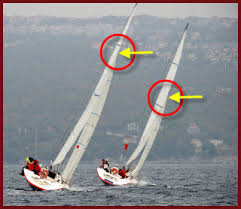

You must know how telltales work to be a successful sailboat racer and those sailors that have mastered their use can be found on the podium more often than not.
Twist is when the top of the sail opens in comparison to the lower sections. This gives us the ability to control the lift and drag created by our sails.
Twist is increased in light winds and progressively taken out as the wind increases. The reason for this is fiction from the water slows the wind on the lower parts of the sail.
In lighter wind, the wind angles up the sail vary greater than they do in heavier winds. You need to twist your sails in light air to make sure they are trimmed correctly all the way up.
As the wind speed increases the surface friction has less of an effect on the wind angle. There is less difference between the top and bottom of the sail so less twist is required.
How to Set Twist for the prevailing conditions.
Headsail:
The luff telltales tell you where the sail is in terms of power and car position, but, when sailing upwind, the leech telltales are absolutely crucial as they show how close you are to maximum trim.
You want to be as close to stalling as possible and your leech telltales are the best indicator of this. Generally, the top leech telltale will stall first so trim the sheet until it stalls.
Once it stalls, ease the sheet slightly until it gets flowing 95% of the time.
As the wind drops the sheet should be eased and as it increases, the trim should come on.
Mainsail:
Trimming the mainsail is virtually identical for all boats, fractional, masthead, racing or cruising and the cunningham, boom vang, backstay, outhaul and running backstays (if fitted) are all used for the same purposes.
On a cat-rigged boat, telltales near the luff can help and are sometimes known as steering telltales.
Set the mainsail with the maximum depth it can carry but without stalling the leech and as with the jib different amounts of twist are needed depending on the prevailing wind conditions.
When sailing upwind twist should be controlled using mainsheet tension, and the correct twist is determined using the mainsail telltales.
A word of warning – If your vang pulled on hard you will not be able to add twist by easing the mainsheet.
When you sail into a lull and the mainsail begins to stall more twist is needed. Once the telltales are stalled the main sheet is eased until they fly again.
For correct trim in lighter air, all mainsail leech ribbons should flow, in moderate conditions, the top leech telltale should flow about 50% of the time.
#sailingtowin #sailing #sail #sailingcoach #yachtrace #sailboatrace
CLICK HERE FOR SAILING TO WIN!

